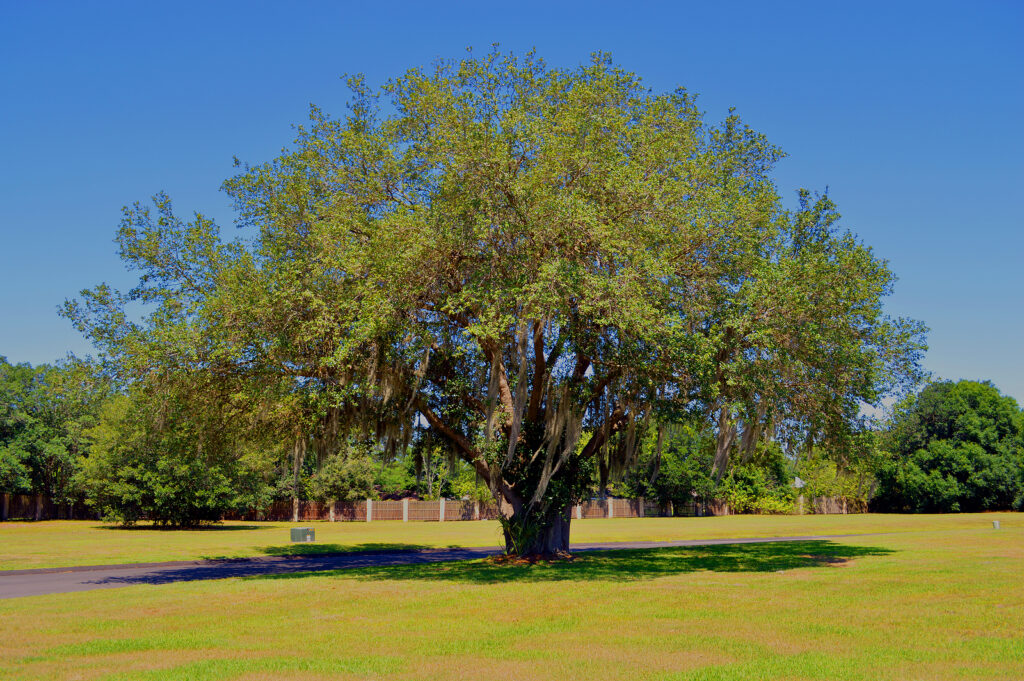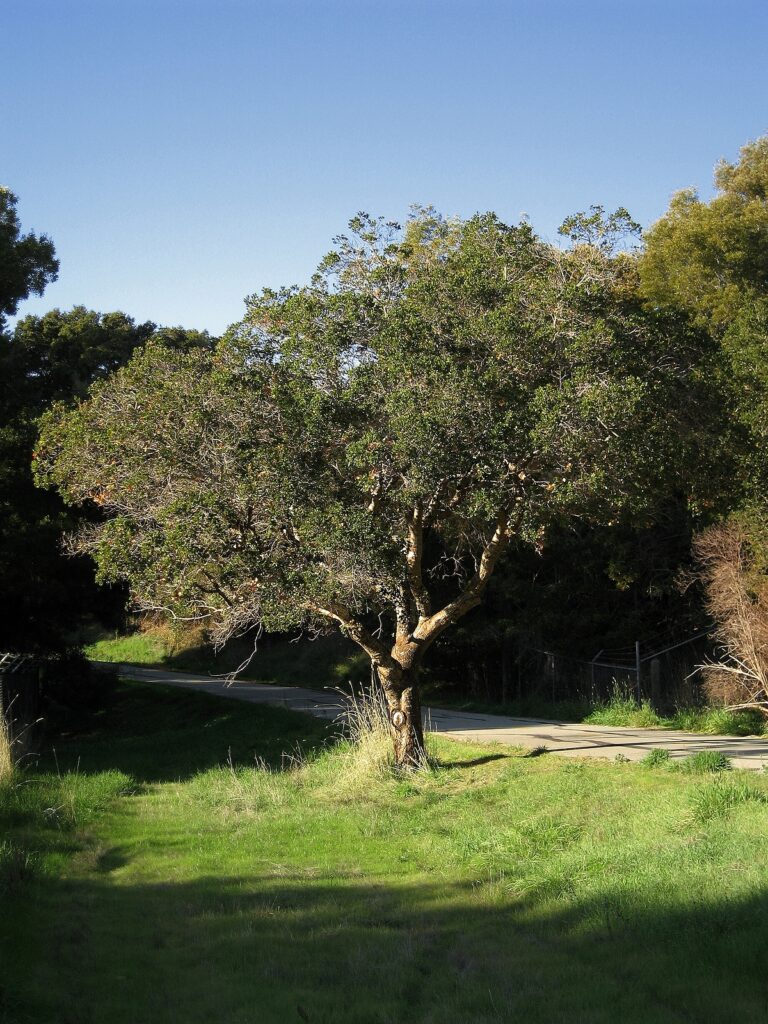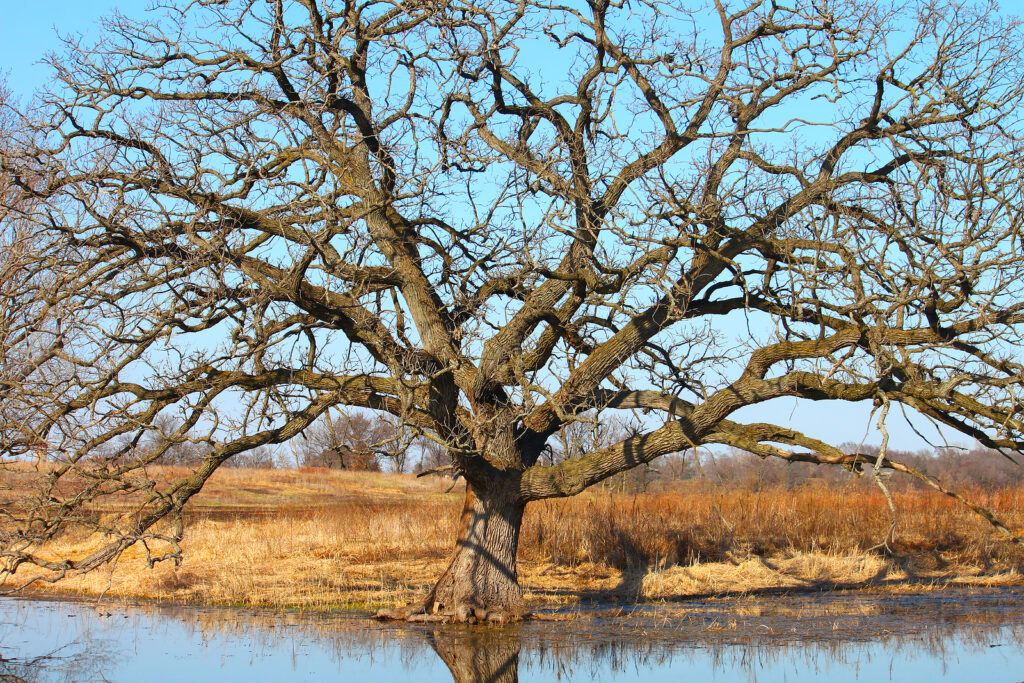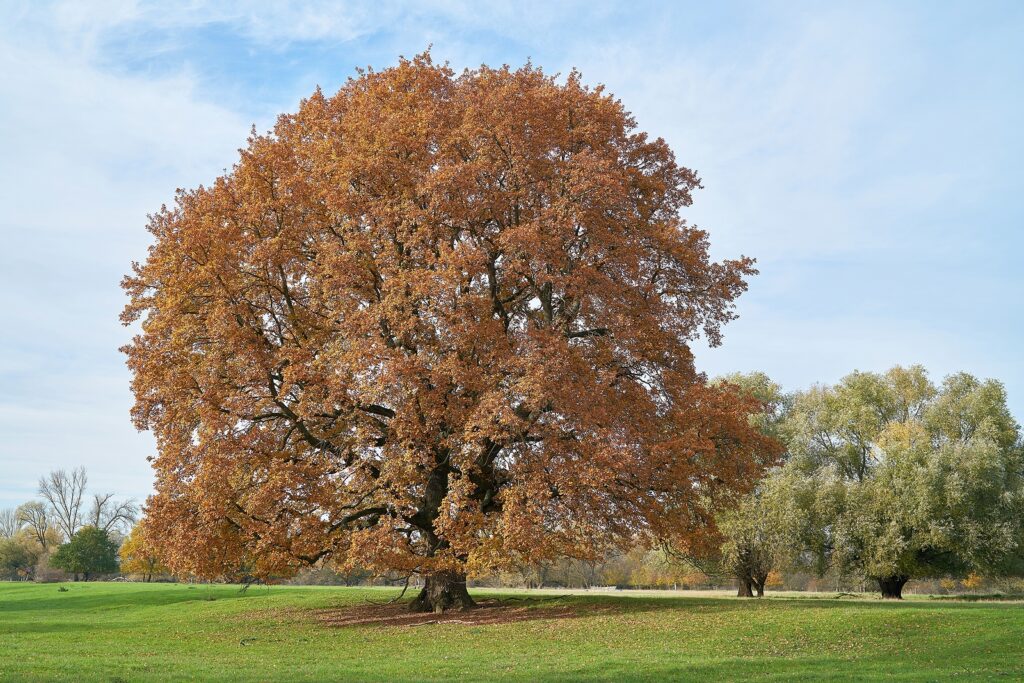Quercus — commonly called Oak–are large long-lived trees that are impressive in the landscape. They are best as specimens in large gardens or parks. Many oaks are inherited; they were present before the land was developed.
Oaks commonly have fissured bark. Their leaves can be entire, lobed, or toothed. A common feature is the production of acorns–single nuts enclosed in cuplike caps that are made up of closely set scales.
There are evergreen and deciduous oaks, most are trees, some are shrubs. The Quercus genus includes about 450 species.
Deciduous oaks are divided into two groups: black (red) oaks with bristle-tipped pointed lobes and acorns that take two years to mature and white oaks with rounded lobes and acorns that take one year to mature. Black (red) oaks include scarlet oak, pin oak, black oak, red oak, and valley oak. White oaks include sawtooth oak, swamp white oak, water oak, willow oak, and English oak.
Evergreen oaks include canyon oak, holly oak, cork oak, and live oak.
There are about 600 species in the Quercus genus. Oaks are widely distributed in woodland and scrub in the Northern hemisphere.

Get to know Quercus
- Plant type: Deciduous, evergreen, or semi-evergreen trees and shrubs
- Growing zones and range: USDA Zones 3 or 4 to 7
- Hardiness: Hardy by variety
- Height and width: 60-70 feet (18.3-21.3m) tall and wide
- Growth rate: Fast
- Form and habit: Rounded
- Foliage: Leaves are alternate and usually lobed, with blunt or pointed tips, but some species have unlobed leaves; usually fissured bark, downy to hairless shoots
- Flowers: Inconspicuous male and female catkins produced separately on the same plant; males are borne in pendent catkins, females singly, in pairs, or racemes
- Fruits: Acorns, single nuts more or less enclosed in a cuplike organ made up of many closely set scales; seeds red in a rough, catlike cup; mostly .5-1.25 inch (1-3cm) long, sometimes more, and solitary or paired, but in some species are borne in racemes
- Bloom time: Midspring to early summer
- Uses: Lawns, large landscapes, specimen, shade, and street use
- Common name: Oak
- Botanical name: Quercus
- Family name: Fagaceae
- Origin: Widely distributed in woodland and scrub in the Northern Hemisphere
Where to plant Quercus
- Plant Quercus in full sun or partial shade; evergreen species prefer full sun.
- Plant Quercus in deep, fertile, well-drained, slightly acid soil; avoid high pH; adapt to various soils.

When to plant Quercus
- Transplant a young dormant container-grown or balled-and-burlapped Quercus to well-drained, slightly acid soil, handling the rootball with care.
- Sow seed in containers in a cold frame or seedbed as soon as ripe.
Planting and spacing Quercus
- Space most Quercus species 40-50 feet (12-15m) apart.
- Don’t plant a new Quercus within the root zone of a tree that has died.
How to water and feed Quercus
- Give Quercus regular to moderate water.
- Feed Quercus with an all-purpose organic fertilizer in spring.

How to care for Quercus
- Avoid pruning Quercus in spring, when bark beetles are most active.
- Prune Quercus during dormancy.
Quercus pests and diseases
- Many diseases and insects attack Quercus, although most are not threatening.
- Quercus are susceptible to attacks by borers, leaf miners, skeletonizers, scale insects, leaf rollers, caterpillars and gypsy moths; heavy infestation can cause defoliation; serious attacks for 2 or more years in a row can weaken or even kill a tree.
- Both caterpillars and gypsy moths tend to be cyclical problems, striking perhaps every 7 to 10 years.
- Tie burlap bands around main trunks to trap gypsy moth larvae; remove and destroy the caterpillars as they accumulate.
- Oak wilt and oak root, fungus diseases, can be a problem too; it is spread by oak bark beetles and by contact between healthy and infected roots; starting from the treetop down, leaves wilt, turn dull, curl, dry, and drop.
- Wilt, anthracnose, twig blight, cankers, powdery mildews, orange hobnail canker, leaf blister (curl or gall), rust, mushroom root rot, white heart rot, and a variety of leaf spots can occur.
Quercus propagation
- Sow seed in containers in a cold frame or seedbed as soon as ripe.
- Graft Quercus in late winter and early spring.

Quercus varieties to grow
- Quercus acutissima, Sawtooth oak, deciduous. Native to China, Korea, and Japan. Moderate to fast growth to 50-70 feet (15-20m) tall and wide, usually with open, spreading habit. Deeply furrowed bark. Bristle-toothed, shiny dark green leaves are 3.5-7.5 inches (8.9-19cm) long, a third as wide; they look like chestnut leaves. Foliage is yellowish on expanding, yellow to yellowish brown in fall; it may hang on late into winter. Fairly tolerant of various soils, though it prefers well-drained acid soil. Stands up well to heat and humidity. No serious problems. Good shade or lawn tree.
- Q. alba, White oak, deciduous. Native from Maine to Florida, west to Minnesota and Texas. Slow to moderate to 60-100 feet (18-30m) tall and wide, taller in wild. Pyramidal when young; in maturity, a majestic round-headed tree, often broader than tall. Leaves are 4-8 inches (10.2-20.3cm) long, dark green above, lighter beneath, with deep, rounded lobes. Fall color varies from brown to wine red. Best in rich, deep, moist, preferably acid soil. One of the handsomest oaks, useful for timber, flooring, and barrel-making, but not widely planted because of its ultimate size and slow growth. Where it occurs naturally, however, it is among the most cherished trees; it is the oak associated with treaty signings and other historic events.
- Q. argifolia, Coast live oak, evergreen. Native to California’s Coast Ranges. Round-headed, dense-foliaged tree to 50-70 feet (15-20m) high, often with greater spread. Smooth dark gray bark; rounded, holly-like, 1-3 inch (2.5-7.6cm) leaves. Attractive green all year unless leaves are devoured by early spring. Despite its faults, a handsome and worthwhile shade or street tree. Can be sheared into a 10-12 foot (3.1-3.7m) hedge.
- Q. bicolor, Swamp white oak, deciduous. Native Quebec to Georgia, west to Michigan and Arkansas. Slow to moderate growth to 50-70 feet (15-20m), rarely taller, and 50 feet (15m) wide. Shallowly lobed or scalloped leaves are 3-7 inches (7.6-17.8cm) long, a little more than half as wide, shiny dark green above, silvery white beneath. Fall color usually yellow, sometimes reddish purple. Bark of trunk and branches flakes off in scales. Tolerates wet soil; also thrives where soil is well-drained. Drought resistant.
- Q. coccinea, Scarlet oak, deciduous. Native Maine to Florida, west to Minnesota and Missouri. Moderate to rapid growth in deep, rich soil. Can reach 70 feet (20m) and 50 feet (15m) wide. High, light, open-branching habit. Bright green leaves are 3-6 inches (7.6-15.2cm) long, a little more than half as wide, with deeply cut, pointed lobes. Foliage turns scarlet where autumn nights are cold. Deep roots. Good street or lawn tree. Fine to garden under.
- Q. imbricaria, Shingle oak, deciduous. Native from Pennsylvania to Georgia, west to Nebraska and Arkansas. Slow growing and pyramidal in youth, eventually growing at a moderate rate into a rounded tree. Can reach 70 feet (20m) and 50 feet (15m) wide, though tree sometimes reaches 100 feet (30m). Shallowly ridged brown-gray bark. Oval, smooth-edged leaves are 2.5-6 inches (6.4-15.2cm) long, half as wide. Foliage is reddish on unfolding, dark glossy green in summer, yellowish brown to brownish red in autumn; often hangs on through winter. Thrives with pruning and can be trimmed into a hedge. Best in rich, deep, moist, well-drained soil; tolerates some drought.
- Q. kelloggii, California black oak, deciduous. Native to mountains from southern Oregon to southern California. Moderate growth to Can reach 70 feet (20m) and 50 feet (15m) wide, upright habit. Dark, furrowed, checked bark. Leaves 4-10 inches (10.2-25.4cm) long, 2.5-6 inches (6.4-15.2cm) wide, with deep, bristle-pointed lobes. Leaves are soft pink or dusty rose when new, bright glossy green at maturity, yellow or yellow orange in fall. Good tree for spring ad fall leaf color, attractive winter trunk and branch pattern.
- Q. macrocarpa, Bur oak, Mossy cup oak, deciduous. Native from Nova Scotia to Pennsylvania, westward to Manitoba and Texas. Rugged-looking tree growing slowly to 50 feet (15m) tall and 30 feet (10m) wide. Deeply furrowed dark gray bark. Leaves are glossy green above, whitish beneath, 4-10 inch (10.2-25.4cm) long and half as wide, broad at tip, tapered at base. Yellowish fall color. Large acorns form in mossy cups. Needs lots of room.
- Q. nigra, Water oak, deciduous. Native to lowland stream banks throughout southeastern U.S. Moderate to fast growth to 50-80 feet (15.2-24.4m) tall and 40 feet (12m) wide, with conical or rounded canopy. Fairly narrow leaves, 1.5-4 inches (3.8-10.2cm) long, vary in shape from obovate to lobed; turn yellow to brown in fall, hang on late. Limbs subject to breakage by wind, snow, ice. Tolerates many soils, but not alkaline ones. Provide moist to wet conditions. Used as shade and street tree.
- Q. palustris, Pin oak, deciduous. Native from Massachusetts to Delaware, westward to Wisconsin and Arkansas. Moderate to fairly rapid growth to 70 feet (20m) tall and 40 feet (12m) wide. Slender and pyramidal when young, open and round headed at maturity. Smooth brownish gray bark becomes shallowly ridged with age. Lower branches tend to droop almost to ground; if lowest whorl is cut away, branches above will adopt same habit. Only when fairly tall will it have good clearance beneath lowest branches. Glossy dark green leaves, 3-6 inches (7.6-15.2cm) long and nearly as wide, are deeply cut into bristle-pointed lobes. In brisk fall weather, leaves turn yellow, red, and finally russet brown; may hang on in winter. Needs plenty of water; tolerates poorly drained soils. Widely used as lawn and street tree.
- Q. phellos, Willow oak, deciduous. Native from New York to Florida, westward to Missouri and Texas. Fast to moderate growth to 50-90 feet (15.2-27.4m) tall. Somewhat like Q. palustris in growth habit and spreading nature, this tree is grown and used in much the same way. Smooth gray bark becomes shallowly ridged in age. Leaves do not resemble those of other common oaks, but look more like willow leaves—2.5-5 inch (6.4-12.7cm)—long, .3-1 inch (.8-2.5cm) wide, smooth edged. Foliage turns yellowish before falling; in warmer regions, dead leaves may hang on through winter. Most delicate foliage pattern of all oaks. Has no serious problems. Will tolerate poorly drained soils.
- Q. prinus, Chestnut oak, Basket oak, deciduous. Native from southern parts of Maine and Ontario southward to South Carolina and Alabama. Moderate growth to an eventual dense, rounded 60-70 feet (18.3-21.3m). Bark often quite dark, even nearly black, becoming deeply furrowed with age. Unlobed leaves with coarse, rounded teeth are 4-6 inches (10.2-15.2cm) long, 1.5-3.5 inches (3.8-8.9cm) wide; in fall, their deep yellowish green color changes to yellow or yellowish brown. This tree tolerates poor, dry, rocky soil but looks better and grows faster with adequate water, good soil. Does not tolerate wet soils.
- Q. robur, English oak, deciduous. Native to Europe, northern Africa, western Asia. Moderate growth to 40-60 feet (12.2-18.3m) in gardens—to 90 feet (27.4m) in wild—with rather short trunk and very wide, open head in maturity. Leaves 3-4.5 inches (7.6-11.4cm) long, half as wide, with three to seven pairs of rounded lobes. Leaves hold until late in fall and drop without much color change.
- Q. rubra, Red oak, Northern red oak, deciduous. Native from Nova Scotia to Pennsylvania, westward to Minnesota and Iowa. Fast growth to 60-75 feet (18.3-22.9m) in gardens—over 100 feet (30m) in wild. Broad, spreading branches and round-topped crown. With age, bark becomes quite dark and fissured. Leaves 5-8 inches (12.7-20.3cm) long, 3-5 inches (7.6-12.7cm) wide, with three to seven pairs of sharp-pointed los. New leaves and leafstalks are red in spring, turning dark red, ruddy brown, or orange in fall. Needs fertile soil and plenty of water. Stake young plants. High-branching habit and reasonably open shade make it a good tree for big lawns, parks, broad avenues. Deep roots make it good to garden under. Usually fairly trouble-free.
- Q. shumardii, Shumard red oak, deciduous. Native from Kansas to southern Michigan, southward to North Carolina and Florida, westward to Texas. Yellow to red fall color. Tolerates drought, wide range of soils.
- Q. virginiana, Southern live oak, evergreen; partly or wholly deciduous in cold-winter regions. Native from Virginia to Florida, westward to Texas. Signature trees of the South. Moderate growth to 40-80 feet (12.2-24.4m) tall, with spreading, heavy-limbed crown up to twice as wide. Very long lived; with age, bark becomes very dark and checked. Smooth-edged, quite narrow leaves, 1.5-5 inches (3.8-12.7cm) long, shiny dark green above, whitish beneath. Old leaves are all shed in spring before new growth emerges. Tree is often draped with Spanish moss. Thrives on moisture and does best in deep, rich soil. Tolerates salt spray. Widely used as street tree in native range. Needs lots of space. A gall insect causes unsightly damage to leaves. Loss of trees to oak wilt has been severe, especially in Central Texas. Termites have killed many live oaks in New Orleans.















